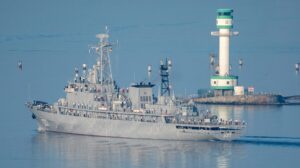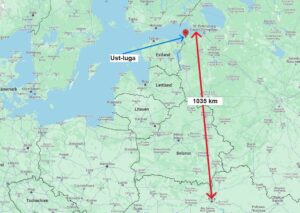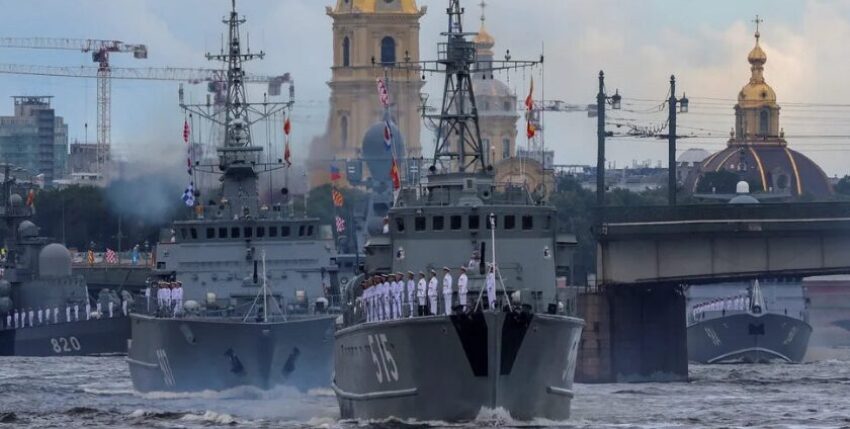Western observers' questions about the surprising departure of three Northern Fleet warships from Baltic Sea waters before St Petersburg Navy Day and the speculation surrounding a finding by the US Institute for the Study of War (ISW) about the threat posed by Ukrainian drones have now been answered:
As the Russian daily newspaper Novye Izvestia reported on its online portal on the morning of 18 July 2024, citing information from the city administration of Saint Petersburg, the main naval parade, which takes place annually in Saint Petersburg on "Naval Fleet Day" in honour of the Navy of the Russian Federation, will be held on 28 July this year with a significantly smaller gallop. The news portal (newizv.ru) even headlines its report in the "News from Russia and the world" section with the striking line: "For the first time in seven years, the main naval parade in Kronstadt has been cancelled!"
According to Novyye Izvestia, the parade will not take place on the usual Kronstadt roadstead. Instead, twelve smaller units will probably sail along the Neva River in parade formation. Other naval units, including submarines, are to be moored close to the centre at mooring buoys in the Neva and in Saint Petersburg and be accessible for sightseeing. The participation of flying units will also be reduced.

It is still assumed that Chinese warships were involved shortly before the event. The Algerian training ship "La Summam" is the only foreign delegation confirmed so far. In addition, the Kremlin has reportedly not yet decided whether Russian President Vladimir Putin will take part. However, Defence Minister Andrei Beloussov and the Commander-in-Chief of the Navy, Admiral Alexander Moiseyev, are to take part in the parade and, if necessary, accept it.
In Saint In St Petersburg, however, preparations for the fleet parade have been running as usual so far. Changed bridge opening times due to trial passages indicated 'business as usual'. The "Grad" and "Naro Fominsk" units of the Buyan M-class, the "Sovetsk" of the Karakurt-class, the minesweeper "Aleksandr Obukhov" of the Alexandrit-class, patrol boats (including the "Nakhimovets" of the Grachonok-class), landing craft and other small units can be seen in photo galleries. The Steregushchiy-class corvette "Boikiy" is also in the fleet - as is the "Ivan Papanin", the type ship of a new series of armed icebreakers, currently on test runs in the Baltic Sea. The "Kronstadt" (B 868), a conventional Lada-class submarine (project 677) that will enter service in January 2024, will be on display.
The drastic "steaming down" of the St Petersburg naval parade could be seen in the context of a finding by the US Institute for the Study of War (ISW). In its 16 July assessment of Russia's war in Ukraine, the Washington think tank states: "Ukrainian drone strikes deep inside Russia continue to put pressure on the Russian air defence umbrella, forcing the Russian military leadership to prioritise the use of limited air defence assets to cover what it considers high-value targets." According to an analysis of satellite images from 6 May, seven medium-range air defence systems are concentrated around the residence of Russian President Vladimir Putin in the Leningrad Oblast. However, the Russian military does not have the number of air defence systems required to protect all critical facilities in western Russia. According to the ISW, this indicates gaps in the extensive air defence.

In addition, Ukraine appears to be able to take successful action against Russian air defence positions. For example, a complete S-300 battery in the Donetsk Oblast was recently reportedly knocked out.
Another reminder: In January 2024, the fire at a fuel terminal in Ust-Luga, around 100 kilometres west of Saint Petersburg, made the headlines - caused by a Ukrainian drone attack. If this were true, then not only Moscow, but even Saint Petersburg could be reached by Ukrainian drones - 1000 kilometres from Kiev - technically quite feasible!
Against this backdrop, a late reassessment of the security situation by Russian services can perhaps be explained as the background for a change in the organisation of the naval birthday parade, which in the past always took place in the presence of President Vladimir Putin.
Background to the Russian Navy Day
Naval Fleet Day is a bank holiday in the Russian Federation that is traditionally celebrated on the last Sunday in July and honours the sailors of the Navy of the Russian Federation and its special units. In 2024 it will be celebrated on 28 July. Since 2017, the central celebrations have been held in Saint Petersburg as a two-hour naval parade with numerous ships and flying units as delegations from the Baltic, Black Sea, Northern and Pacific Fleets as well as the Caspian Flotilla. Events are also held at other naval bases. Alongside Victory Day on 9 May (end of the Second World War in 1945), Russian Navy Day is the second highest military holiday in Russia alongside the days of honour of the other, less spectacular branches of the armed forces.
History
The Imperial Russian Navy was founded in 1696 as an amalgamation of smaller regional naval units to protect the Tsarist Empire. In 1714, Peter I the Great introduced the Day of the Fleet on 27 July in honour of the victorious naval battle of Gangut (Hanko peninsula in the southwest of Finland, Russia against Sweden in the Great Northern War). The organisation of this day varied over the years and in the 19th century it became customary for the ships to fire a salute on this day and for chains of lights to be set up in the evening to decorate the flags. After the October Revolution, of course, this had to be changed, and in 1920 the holiday following 18 May was designated as "Red Fleet Day". Later, in 1939, the Central Committee of the CPSU and the Council of People's Commissars of the USSR designated 24 July as "Naval War Fleet Day". At the end of 1980, the Presidium of the Supreme Soviet of the USSR, as the collective head of state of the Soviet Union, established this day as the last Sunday of July (with a variable date). In 2017, President Putin had the Day of the Naval War Fleet publicly honoured by reviving the former naval parade in Saint Petersburg.









4 responses
Some of the articles/reports/brief reports on the Russian naval fleet published in MARINEFORUM are superficial and contain factual errors and judgements.
Dear Dr Pfeiffer - how nice to hear from you on this portal.
Our articles on marineforum.online are brief, but not superficial.
They are of course judgemental, because that is what drives us.
Factual errors should of course be avoided, but if they do occur, we are grateful for relevant information and will correct ourselves as far as possible.
With kind regards
Axel Stephenson
Editorial team marineforum.online
As is so often the case in this newspaper, when it comes to Russia, they don't take things too seriously when it comes to factual statements. Once again, a text module was used that was published a few years ago. The naval parade is part of the celebrations on "Naval Fleet Day" and not the other way round, as described in the article. The "Day of the Fleet" was introduced in honour of the victory of the Battle of Gangut (Hanko) in 1714 and set by Peter the First on 27 July. The organisation of the day (parades, prayers...) changed over time and by the middle of the 19th century it had become customary for the ships to be illuminated and salutes to be fired on this day. This changed after the October Revolution and it was not until 1920 that it was decided that the day off following 18 May would be celebrated as "Red Fleet Day". In a directive dated 22 June 1939, 24 July was designated as Naval War Fleet Day and on 1 October 1980 it was decided that "Naval War Fleet Day" would be celebrated on the last Sunday in July. It was therefore not abolished. Whether and how the Russian side organises this day, who takes part or who does not take part for what reason, are solely Russian decisions. Incidentally, it has not been cancelled, but will only be held on a smaller scale. The inhabitants of Kronstadt are not necessarily sad about this.
Dear Mr Neidel - thank you for your comments.
After further research, I have made a correction in the text, incorporating your information.
With best regards
Axel Stephenson
Editorial team marineforum.online